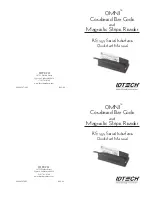
ID TECH VP3300 OEM User Manual
Page | 11
plastic, should at a minimum be of 30% glass-filled plastic because the card’s edge will
inevitably scrape that surface upon entering and exiting the card swipe. We recommend
having stainless steel surfaces on both the entrance and exit area surfaces or have them
substantially below the rail’s reference surface.
4.3.
Card Reader Rails/Slot and Magnetic Head Protrusion
When designing a card reader, engineers must consider the thickness of the media used.
Magnetic media comes in various thicknesses, but most readers use cards that are nominally
0.030 inches thick +/- 10%
. Some applications do occur where the media is thinner, normally in
specialized applications where the media can be as thin as 0.010 inches thick (such as the paper
cards used for many parking lot paper tickets).
To accommodate media with minimum and maximum thicknesses, the slot needs to be a
between 0.040 and 0.050 inches wide in an area a minimum of 0.5 inches on either side of the
centerline of the magnetic head’s gap (this gap is located at the apex of the head’s radius). The
remaining portion of the rails (slot width) can be wider, but never smaller; also remember that it is
best to have the reference surface/wear-plate extend for a minimum of 1.5 inches from the
magnetic head’s gap.
1.
Magnetic heads need to be able to rotate on a gimbal (refer to
Figure 3
for an example) to
compensate for tilting cards, and therefore must have a minimum deflection. For
credit/debit cards used in financial transactions or other applications using standard
thickness cards (0.030 /- 10%), the magnetic head’s gap (the apex of the protruding
radius) should be spaced within 0.010 +/- 0.003 inches from the opposing rail/wall.
To ensure reliable read rates on thinner cards, the head must contact the media and be
deflected by a minimum of 0.007 inches (0.18mm); this is regardless of the media thickness,
or head configuration. For example, if the media is 0.010 inches (0.25mm) thick, the head
face must be positioned a maximum of 0.003 inches (0.08mm) from the opposite wall. To
avoid damaging the gap material the head should not contact the opposing rail/surface in
the card slot.
4
Note: 0.030-inch thickness is the dimension for all credit and debit cards, and is common for other cards as
well.



































